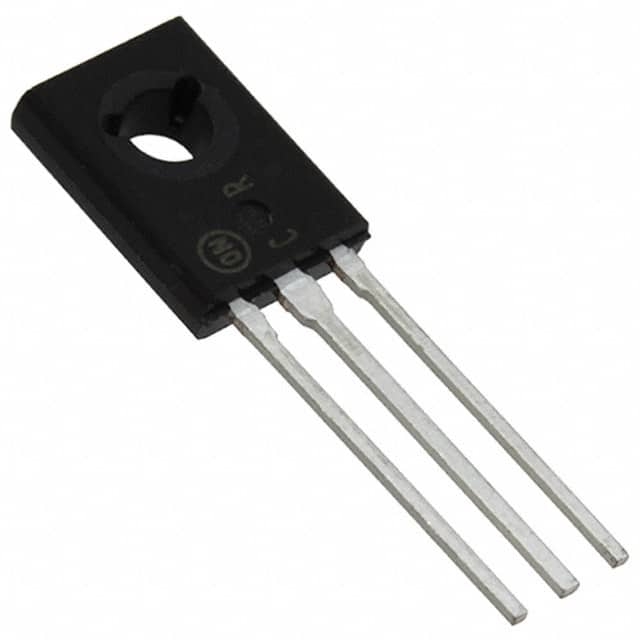2N4923G Transistor
Product Overview
The 2N4923G is a general-purpose PNP bipolar junction transistor (BJT) belonging to the category of electronic components. It is commonly used in amplification and switching applications due to its versatile characteristics. The transistor comes in a TO-92 package and is available in various packaging quantities, making it suitable for both hobbyist and professional use.
Basic Information
- Category: Electronic Components
- Use: Amplification and Switching
- Characteristics: General Purpose, PNP Type
- Package: TO-92
- Packaging/Quantity: Various options available
Specifications
The 2N4923G transistor has the following specifications: - Collector-Base Voltage: -40V - Collector-Emitter Voltage: -40V - Emitter-Base Voltage: -5V - Collector Current: -0.6A - Power Dissipation: 625mW - Transition Frequency: 100MHz
Detailed Pin Configuration
The 2N4923G transistor has three pins: 1. Collector (C): Connected to the positive supply voltage when used in common-emitter configuration. 2. Base (B): Input terminal for controlling the flow of current between collector and emitter. 3. Emitter (E): Connected to the ground or negative supply voltage when used in common-emitter configuration.
Functional Features
The 2N4923G transistor offers the following functional features: - High current gain - Low saturation voltage - Fast switching speed
Advantages and Disadvantages
Advantages
- Versatile application in amplification and switching circuits
- Compact TO-92 package for easy integration into circuit designs
- High transition frequency for improved high-frequency performance
Disadvantages
- Limited maximum collector current compared to power transistors
- Moderate power dissipation capability
Working Principles
The 2N4923G operates based on the principles of bipolar junction transistors, where the flow of current between the collector and emitter is controlled by the base current. In amplification applications, small changes in the base current result in larger changes in the collector current, enabling signal amplification. In switching applications, the transistor can rapidly switch between on and off states, allowing it to control the flow of current in a circuit.
Detailed Application Field Plans
The 2N4923G transistor finds extensive use in various electronic applications, including: - Audio Amplifiers - Signal Processing Circuits - Switching Circuits - Oscillator Circuits - Voltage Regulators
Detailed and Complete Alternative Models
Some alternative models to the 2N4923G transistor include: - 2N4403 - BC557 - MPSA42 - 2N3906
In conclusion, the 2N4923G transistor is a versatile electronic component with applications in amplification and switching circuits. Its compact package, functional features, and wide-ranging specifications make it a popular choice for diverse electronic projects.
[Word Count: 426]
قم بإدراج 10 أسئلة وإجابات شائعة تتعلق بتطبيق 2N4923G في الحلول التقنية
What is the 2N4923G transistor used for?
- The 2N4923G is a general-purpose NPN bipolar junction transistor commonly used for amplification and switching applications in electronic circuits.
What are the typical operating conditions for the 2N4923G?
- The 2N4923G transistor typically operates at a maximum collector-emitter voltage of 40V and a maximum collector current of 500mA.
Can the 2N4923G be used for audio amplification?
- Yes, the 2N4923G can be used for small-signal audio amplification due to its low noise and high gain characteristics.
Is the 2N4923G suitable for switching applications?
- Yes, the 2N4923G can be used for low-power switching applications due to its moderate switching speed and current-handling capabilities.
What are the common circuit configurations for using the 2N4923G?
- The 2N4923G can be used in common emitter, common base, and common collector configurations depending on the specific application requirements.
Are there any thermal considerations when using the 2N4923G?
- Yes, it's important to consider the thermal dissipation of the 2N4923G transistor, especially when operating at higher currents, to prevent overheating and ensure reliability.
What are the typical gain characteristics of the 2N4923G?
- The 2N4923G transistor has a moderate to high current gain (hFE) which makes it suitable for various amplification applications.
Can the 2N4923G be used in low-power voltage regulator circuits?
- Yes, the 2N4923G can be utilized in low-power voltage regulator circuits to provide stable output voltage regulation.
What are the recommended storage and operating temperature ranges for the 2N4923G?
- The 2N4923G is typically rated for storage and operating temperatures ranging from -65°C to 150°C, making it suitable for a wide range of environments.
Are there any common failure modes associated with the 2N4923G?
- Common failure modes include thermal runaway at high currents, overvoltage breakdown, and excessive power dissipation leading to device failure. Proper heat sinking and voltage regulation can mitigate these risks.


